- Publisher's Note
- Editorial
- What's Behind This Orange Facade!
- “First you are drawn in by something akin to beauty and then you feel the despair, the cruelty.”
- Art as an Effective Tool against Socio-Political Injustice
- Outlining the Language of Dissent
- Modern Protest Art
- Painting as Social Protest by Indian artists of 1960-s
- Awakening, Resistance and Inversion: Art for Change
- Dadaism
- Peredvizhniki
- A Protected Secret of Contemporary World Art: Japanese Protest Art of 1950s to Early 1970s
- Protest Art from the MENA Countries
- Writing as Transgression: Two Decades of Graffiti in New York Subways
- Goya: An Act of Faith
- Transgressions and Revelations: Frida Kahlo
- The Art of Resistance: The Works of Jane Alexander
- Larissa Sansour: Born to protest?!
- ‘Banksy’: Stencilised Protests
- Journey to the Heart of Islam
- Seven Indian Painters At the Peabody Essex Museum
- Art Chennai 2012 - A Curtain Raiser
- Art Dubai Launches Sixth Edition
- "Torture is Not Art, Nor is Culture" AnimaNaturalis
- The ŠKODA Prize for Indian Contemporary Art 2011
- A(f)Fair of Art: Hope and Despair
- Cross Cultural Encounters
- Style Redefined-The Mercedes-Benz Museum
- Soviet Posters: From the October Revolution to the Second World War
- Masterworks: Jewels of the Collection at the Rubin Museum of Art
- The Mysterious Antonio Stellatelli and His Collections
- Random Strokes
- A ‘Rare’fied Sense of Being Top-Heavy
- The Red-Tape Noose Around India's Art Market
- What Happened and What's Forthcoming
- Art Events Kolkata, January – February 2012
- Mumbai Art Sighting
- Art Bengaluru
- Delhi Dias
- Musings from Chennai
- Preview, February, 2012 – March, 2012
- In the News-February 2012
- Cover
ART news & views
Delhi Dias
Issue No: 26 Month: 3 Year: 2012
by Lopamudra Pakira
Much to See and Lot to Believe In
 Neha Kirpal's great gamble seems to have paid off-- at least for now--as the art crowd turned out in huge numbers for the last day of the India Art Fair. The gallerists, undaunted by five straight days of exhibiting, went on a charm offensive to make last minute sales. While these transactions were carried on in discreet corners of the stalls, and were mainly done by seasoned collectors, the general public ambled through the large tent, often making it difficult for gallerists to control their movement through their stalls. Kirpal however was elated with the numbers, calling it a 'tremendous quality step up' from the last Fair. The country's biggest art event was back with the 4th edition of India Art Fair 2012, formerly known as the India Art Summit. The art fair was held at the NSIC Exhibition Complex in Okhla, one of Delhi's biggest grounds. This year the fair hosted works from 98 of the world's most exciting and influential artists and galleries from 20 countries over four days.
Neha Kirpal's great gamble seems to have paid off-- at least for now--as the art crowd turned out in huge numbers for the last day of the India Art Fair. The gallerists, undaunted by five straight days of exhibiting, went on a charm offensive to make last minute sales. While these transactions were carried on in discreet corners of the stalls, and were mainly done by seasoned collectors, the general public ambled through the large tent, often making it difficult for gallerists to control their movement through their stalls. Kirpal however was elated with the numbers, calling it a 'tremendous quality step up' from the last Fair. The country's biggest art event was back with the 4th edition of India Art Fair 2012, formerly known as the India Art Summit. The art fair was held at the NSIC Exhibition Complex in Okhla, one of Delhi's biggest grounds. This year the fair hosted works from 98 of the world's most exciting and influential artists and galleries from 20 countries over four days.
The fair included a Speakers' forum, book launches, video lounge, collateral events and interactive art projects. The Speakers' forum featured 54 eminent names including art expert Priyanka Matthew of Sotheby's and artists Mark Quinn and Bharti Kher. In addition, the fair also included interactive visits to artists' studios in Shahpur Jat to witness contemporary artists creating their best works. Guided tours and curated walks by artists and students of art history have also been introduced for general visitors.
 The Art Fair also emerged as a pivotal meeting point for international buyers to exchange notes and buy work from each other. "We have foreign galleries commissioning Indian artists and vice-versa. The fair has become truly international in nature,“ claimed Kirpal, adding that it wasn't just Christie's and Sotheby's that showed interest, but also collectors from New York, Australia, Indonesia, Sao Paolo, Israel and China. The surprise factor, it seems, has been that even insular Chinese collectors have taken initial steps towards patronizing Indian art. There was also a spurt in tier-two collectors from smaller cities like Ahmedabad, Jalandhar and Jaipur, and corporate commissions by multi-nationals, who've recently begun to build collections.
The Art Fair also emerged as a pivotal meeting point for international buyers to exchange notes and buy work from each other. "We have foreign galleries commissioning Indian artists and vice-versa. The fair has become truly international in nature,“ claimed Kirpal, adding that it wasn't just Christie's and Sotheby's that showed interest, but also collectors from New York, Australia, Indonesia, Sao Paolo, Israel and China. The surprise factor, it seems, has been that even insular Chinese collectors have taken initial steps towards patronizing Indian art. There was also a spurt in tier-two collectors from smaller cities like Ahmedabad, Jalandhar and Jaipur, and corporate commissions by multi-nationals, who've recently begun to build collections.
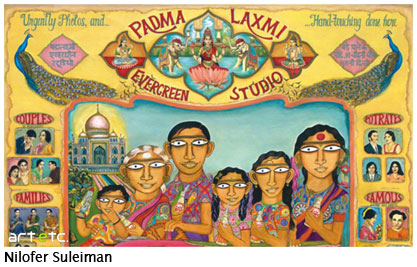 Neha Kirpal, Founding Director of India Art Fair said: “The art fair has seen tremendous growth over a short period of time, and much of its success can be attributed to its focus on providing a relevant and transparent platform for the Indian art scene. It has received unprecedented interest from international museums and private collectors, and cultivated a whole breed of new collectors and art enthusiasts within India. This edition has exceptional gallery presentations of both Indian and international art, and a wide reaching public programme.”
Neha Kirpal, Founding Director of India Art Fair said: “The art fair has seen tremendous growth over a short period of time, and much of its success can be attributed to its focus on providing a relevant and transparent platform for the Indian art scene. It has received unprecedented interest from international museums and private collectors, and cultivated a whole breed of new collectors and art enthusiasts within India. This edition has exceptional gallery presentations of both Indian and international art, and a wide reaching public programme.”
Eminent artists and galleries displaying their work included Hauser & Wirth who showcased sculptures by Subodh Gupta and works by Bharti Kher, Louise Bourgeois, Roni Horn and Paul McCarthy; Gallery Maskara showcased new works by T Venkanna, Shine Shivan and Prashant Pandey; and Gallery Espace displayed painted autobiographical sketchbooks of artists such as Gulam Sheikh and Anju Dodiya along with works of Manjunath Kamath and Ravinder Reddy. Indian galleries at the Fair included Delhi Art Gallery, The Guild Art Gallery Mumbai and Artchill from Jaipur while International galleries comprised of Sundaram Tagore Gallery Hong Kong, White Cube and Hauser & Wirth both from London. Artists to watch out for at the Fair included Robert Indiana from Paul Kasmin; Gigi Scaria from Palette; Mona Hatoum, Marc Quinn, Damien Hirst from White Cube, Marina Abramović from Lisson Gallery and Annie Leibovitz from Sundaram Tagore Gallery Hong Kong.
India revels in creating pockets of excellence out of urban noise, and at turning logic on its head. It also loves creating tamashas (spectacles). That is what has happened at the four-day (25th January to 29th January, 2012) India Art Fair, an event that saw families and young children mixing with serious art collectors and buyers, and which closed Sunday night in New Delhi. One can feel the future of the Indian art market here. The event, previously called the Art Summit, is unusual on the international art circuit because it aims to both educate the Indian public about the art world and provide sales and high-value contacts for some 90 exhibitors (selected from over 250 applicants). This leads to some tensions, as high-end foreign galleries and Indian collectors would prefer a more exclusive audience of potential buyers, rather than a large public showing. Half the galleries came from India and the rest were international names such as Hauser & Wirth, Lisson, White Cube and Other Criteria, with artists ranging from Picasso to Marina Abramovic, a New York-based Serbian performance artist. Other artists included renowned Indian masters, such as M.F. Husain and S.H. Raza, well as Anish Kapoor, Damien Hirst and Martin Creed.
There were not enough buyers to boost India's sluggish modern and contemporary art market, but most galleries reported some sales or suggested negotiations for future deals. A few big Indian collectors were visible buyers, such as Kiran Nadar, who has set up a modern art museum in Delhi. Ms. Abramovic appeared to be particularly popular for her video work, though it isn't clear whether any of her pieces have sold. Hence, after a roller-coaster ride, India's art market seems to be on stable ground.
While there was the fair that was pulling a lot of crowd to the NSIC grounds, there were quite a lot of breathtaking shows in and around Delhi. Here is a peek- a- boo of the most interesting shows in and around the latest art hubs in the metropolitan.
Fissures and Ruptures
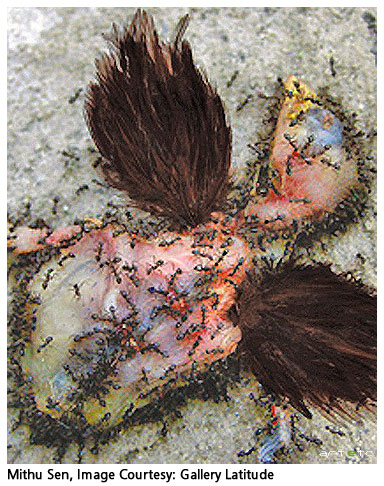 Slipping Through the Cracks curated by Meera Menezes at Latitude 28 investigates the systemic erasure that accompanies a dizzying accumulation of information in an increasingly digitalized and virtual world. The exhibition dwells on the mechanisms of this erasure and the deeper ramifications when people and historical events get swallowed up by the cracks of memory and history. While some vignettes of information go viral, enjoying an unimaginable circulation, others languish for want of a digital trace. What transpires when a Google or Wiki search fails to throw up any mention of bygone moments in history? Do they cease to exist simply because they leave no digital footprint or are no longer referenced and are consequently lost forever to posterity?
Slipping Through the Cracks curated by Meera Menezes at Latitude 28 investigates the systemic erasure that accompanies a dizzying accumulation of information in an increasingly digitalized and virtual world. The exhibition dwells on the mechanisms of this erasure and the deeper ramifications when people and historical events get swallowed up by the cracks of memory and history. While some vignettes of information go viral, enjoying an unimaginable circulation, others languish for want of a digital trace. What transpires when a Google or Wiki search fails to throw up any mention of bygone moments in history? Do they cease to exist simply because they leave no digital footprint or are no longer referenced and are consequently lost forever to posterity?
Slipping Through the Cracks invites a clutch of twelve artists, Anita Dube, Archana Hande, Arun Kumar HG, Atul Bhalla, Baptist Coelho, Hemali Bhuta, Jagannath Panda, Mithu Sen, Prajjwal Chowdhury, Raqs Media Collective, Sheba Chhachhi, Shreyas Karleto examine this phenomenon of leakage and loss in both the virtual and the real worlds. Are there perhaps cracks/fissures/ruptures in the political, social or gender fabric?The artists also embark on an investigative journey to see whether these spaces and interstices within the cracks can in turn form sites of resistance or offer possibilities of generating new meaning. Their works traverse these spaces between spaces and tarry in this in-between-ness that the cracks offer.
Ground-breaking renewals
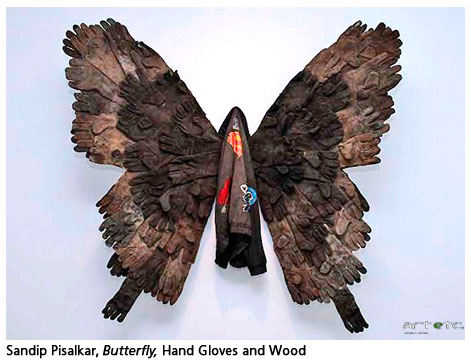 The city saw some creative art work when Rasika Kajaria of Exhibit 320 Lado Sarai hosted the preview opening of The Construction of Loss, a group show of Paintings & installations. On display were some unique & experimental art works by artist Rahul & Gunjan, Charmi Gada Shah, Kuldeep Singh, Priti Vadakkath, Sandip Pisalkar & Sachin George Sabastian. Construction and Deconstruction are simultaneous processes. A building rests half-done or half-undone. Our lives hover in in-between psyches of uncertainty. The past is shed and simultaneously accumulated towards the future. The natural world and the structured world are constantly in tandem. The construction of loss is about the creation of a positive space through a mental one: about that liminal stage between loss and renewal and between identity-lessness and self-knowledge.
The city saw some creative art work when Rasika Kajaria of Exhibit 320 Lado Sarai hosted the preview opening of The Construction of Loss, a group show of Paintings & installations. On display were some unique & experimental art works by artist Rahul & Gunjan, Charmi Gada Shah, Kuldeep Singh, Priti Vadakkath, Sandip Pisalkar & Sachin George Sabastian. Construction and Deconstruction are simultaneous processes. A building rests half-done or half-undone. Our lives hover in in-between psyches of uncertainty. The past is shed and simultaneously accumulated towards the future. The natural world and the structured world are constantly in tandem. The construction of loss is about the creation of a positive space through a mental one: about that liminal stage between loss and renewal and between identity-lessness and self-knowledge.
Even if the whole process in tad tangled, the mediums dabbled with are very innovative. For example the eye catchy “butterfly” made with hundred workers (of GIDC) gloves is an iconic statement about the privilege and gravity of flight, and the paradoxical acceptance of the manual among the natural. Works that will blow your mind are on display till the 22nd of February, 2012.
It's all about ME
 For their debut in the fair, Gallery Art Positive has chosen the theme of “Aham, I, me mine”, which can be interpreted as an individual's voice that resounds in contemporary self-centered society. This theme has been explored by the invited group of artists, some of whose work is directly autobiographical in essence, while others reflect their experiences, views or angst more subtly. Satish Gupta's mixed media paintings reflect on the theme through their ethereal creations, sculptor Dhananjay Singh and painter Nitish Bhattacharya do so in their abstract renditions. Shipra Bhattacharya's paintings examine the theme from their feminist perspective.
For their debut in the fair, Gallery Art Positive has chosen the theme of “Aham, I, me mine”, which can be interpreted as an individual's voice that resounds in contemporary self-centered society. This theme has been explored by the invited group of artists, some of whose work is directly autobiographical in essence, while others reflect their experiences, views or angst more subtly. Satish Gupta's mixed media paintings reflect on the theme through their ethereal creations, sculptor Dhananjay Singh and painter Nitish Bhattacharya do so in their abstract renditions. Shipra Bhattacharya's paintings examine the theme from their feminist perspective.
Dileep Sharma's work, for instance, is an imagery of pop culture, sexuality and socio-political issues as reflected in the interface between ethnic mythology and modern urban life of today. Fashion forms a quintessential part in his work. The models in his painting are fashionable, flamboyant and glamorous totems of the contemporary.
On the other hand, Vineet Kacker's work pays homage to the phenomenon of wayside street shrines all over India, from austere Himalayan ones to kitschy urban ones, where associations of faith, often contested, have the ability to transform the meaning of ordinary objects. While script is often used as a device to add different layers of subtext, the use of the metal bell is a more direct effort to create a participative ritual around an object, to change the meaning with which an object may be viewed.
Jagdish Chinthala's sculptures reflect man-woman relationship. Emotions are bonded in many variations, their subtleties range and vary, to conform principally to the same way world over.
Go Goa
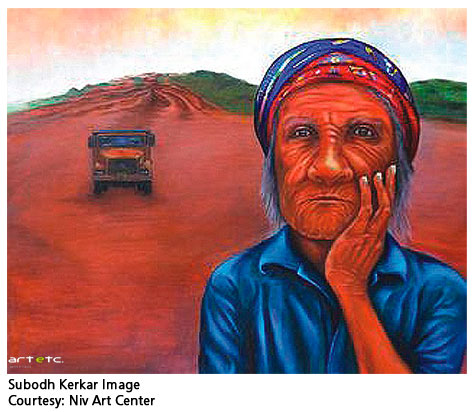 NIV art centre presents a mode of practice that gives better connectivity and confidence to each of the components to play their roles in the field conveniently as, creator/producer-- provider/distributor-- and audience/consumer. To establish this vital relationship and to bridge the gap in between this essential components of art practice the niv art centre is prepared to provide a platform for the purpose, for aspiring players in the field, while keeping up the historical traditions of art studio disciplines.
NIV art centre presents a mode of practice that gives better connectivity and confidence to each of the components to play their roles in the field conveniently as, creator/producer-- provider/distributor-- and audience/consumer. To establish this vital relationship and to bridge the gap in between this essential components of art practice the niv art centre is prepared to provide a platform for the purpose, for aspiring players in the field, while keeping up the historical traditions of art studio disciplines.
Niv art center, presents Goa Reloaded, an exhibition featuring 16 Goan artists who will showcase over 70 paintings, sculptures and installations. The show features works of Subodh Kerkar, Pradeep Naik, Viraj Naik, Shilpa Naik, Santosh Morajkar, Chaitali Morajkar, Shripad Gurav, Ramdas Gadekar, Vaibhava Kitlekar, Aadhi Vishal, Harshada Kerkar, Vitesh Naik, Siddharth Gosavi, Sachin Naik, Vijai Bhandare and Kedar Dhondu. Subodh Kerkar will show his new works created with truck tyres, while Sachin Naik has created some large wood-cuts. Vaibhava Kitlekar's sculptures are hybridization of a cow head with human forms. Ramdas Gadekar expresses his concern over environmental pollution by mining. His very expressive heads juxtaposed on red mining dumps are very impressive. Pradeep Naik uses sculptures from Goan cemeteries along with floral designs in his large canvases. The show is perhaps the best show so far of contemporary Goan art since liberation and will draw large audience in New Delhi.
Thresholds and Boundaries
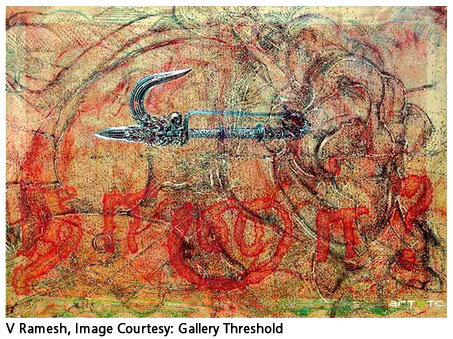 Among the few artists who have consistently chosen to investigate the elusive and complex subject of "the metaphysical ", in his paintings, V Ramesh presents his new body of work: Why Cross the Boundary in oils on canvas, each sensuously atmospheric work akin to a contemplative experience in Gallery Threshold. His paintings large in scale are best described as metaphysical allegories for his own rite of passage through art and life. References to sages, mystics and poets communicate ideas whose multiple associations have been drawn from cultural and personal memory.
Among the few artists who have consistently chosen to investigate the elusive and complex subject of "the metaphysical ", in his paintings, V Ramesh presents his new body of work: Why Cross the Boundary in oils on canvas, each sensuously atmospheric work akin to a contemplative experience in Gallery Threshold. His paintings large in scale are best described as metaphysical allegories for his own rite of passage through art and life. References to sages, mystics and poets communicate ideas whose multiple associations have been drawn from cultural and personal memory.
Without ritual, prayer or dogma, the artist's fluid layers of colour as dominant stratosphere, create worlds within worlds. His cast of women saint poets featured in the intriguingly titled Why Cross the Boundary includes Karaikkal Amma (5th century), Mahadevi Akka (12th Century) and Lal Ded (14th Century). Each lived in different parts of India through different periods of the country's history, and wrote their poems in different languages. According to the artist, “despite these vast divisions, all three shared a similar intoxication in their pursuit of the divine. Each had in common their unique, personal histories.”
Real, Unreal, Surreal

Art Heritage brings to the lime light Sudhansu Sutar. Sutar's work exemplifies the story Indian artists can tell about cultural upheaval in a globalizing world. His paintings isolate rajas, Gandhi, Deers and other avatars of Indian culture in bleak, Daliesque landscapes, littered with detritus of the modern era. The artist says his compositions intentionally make their subject ever more "a prisoner of the times". Sudhanshu's work is a fusion of rural, psycho-surreal imagery and tropes of survival in the big city that draws both on his life in Delhi and his roots in the southeastern state of Orissa. For the struggling young artist, the future seemed to lie elsewhere.
Sudhanshu's compositions of collected images therefore go beyond surface readings leaving ample scope for decoding. An artist of consummate skill Sudhanshu carefully selects images, placing them in evocative landscapes that allow for exploiting all that acrylic as a medium, enables. The exhibition shall be on from the February 17th and shall continue till the march 13th, 2012.